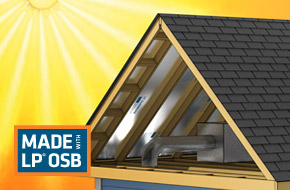Home Building Articles
Not All Radiant Barriers are Created Equal
December 21, 2010

The U.S. Department of Energy recognizes radiant barriers as a way to reduce summer
heat gain and lower cooling energy usage. An independent study in 2010 by ConSol
reinforced this, finding that radiant barrier sheathing is a top energy-efficient
technology when building a new home.
The study indicated that radiant barrier sheathing is on of the top three energy-efficient
technologies in new home construction in term of performance, cost and return on
investment.
Correctly installed, radiant barrier sheathing can block up to 97 percent of the
radiant heat in the roof panel from entering the attic. This can lower the temperature
in the attic by as much as 30 degrees and reduce cooling costs by up to 17 percent.
A cooler attic will benefit your attic-installed air handling system and in some
cases reduce the tonnage required in an HVAC system.
To be considered a radiant barrier, a product must adhere to industry standards
set by the American Society of Testing and Materials International. A radiant barrier
may not transfer more that 10 percent of the radiant heat energy applied to it.
But even with these strict standards, not all radiant barriers are the same. One
critical factor to keep in mind is how the radiant barrier handles moisture during
and after the construction phase.
Radiant barrier sheathing typically consists of a structural OSB panel with a layer
of aluminum adhered to the surface. Some manufacturers perforate the foil layer
to protect against moisture issues. Yet this may not necessarily allow the panel
to breathe, because the perforations do not extend into the panel. An added challenge
is that the adhesive used to apply the radiant barrier to the substrate can fill
in the perforations, decreasing the ability of moisture in the panel to escape.
One product on the market, LP® TechShield® Radiant Barrier Sheathing, addresses
the issue of moisture through the use of innovative technology. LP's patented VaporVents™
technology features incisions that penetrate past the foil and glue and into the
wood fiber, allowing the panels to breathe and moisture to escape.
In tests, VaporVents technology allowed the LP TechSheild panel to dry almost as
efficiently as OSB sheathing without a radiant barrier.
"VaporVents technology allows LP Techshield panels to within two percent of standard
OSB sheathing while other products that use pre-perforated foil showed a significant
amount of moisture still in the panel after 80 days of drying," said David Drew,
OSB Technical Sales Manager for LP Building Products.